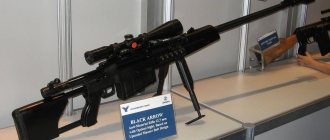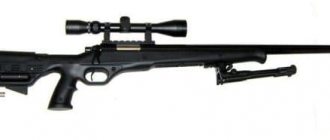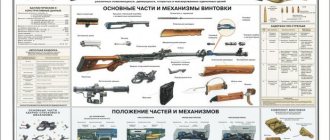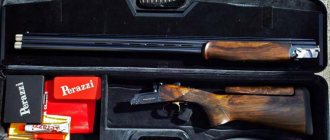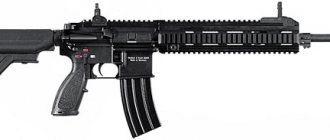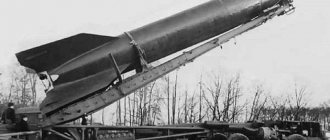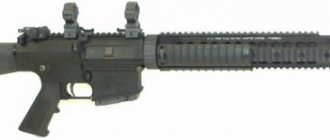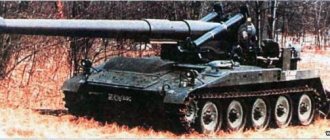Modifications
- TOZ-8
is the basic model of the rifle, produced from 1932 until the end of the Great Patriotic War - TOZ-8M
is a modified version of the rifle, production began after the end of the Great Patriotic War. Unlike the basic modification of the rifle, the TOZ-8M rifle has a sector-type sight, which allows it to be adjusted in height. The front sight is equipped with a ring earpiece. The bolt of the TOZ-8M rifle has a smaller diameter bolt and does not have a clutch, making the rifle more convenient to reload. The rifle stock has a wider fore-end. - TOZ-9
is a magazine version of the rifle, developed in 1933 by designer D.I. Kochetov based on the TOZ-8 rifle. The TOZ-9 rifle has a box magazine that holds 4 cartridges, the fifth cartridge is in the chamber. The magazine is located inside the rifle stock, is inserted from below and is secured against falling out with a latch. - TOZ-11
is a lightweight version of the rifle developed in 1946 by designer K.I. Shikhvatov especially for commercial hunters. Produced from 1946 to 1957. Rifle weight 2 kg. The rifle had a new birch stock. - TOZ-12
rifle model was developed by designer D.M. Kochetov based on the TOZ-8 rifle. - TOZ-16
is a rifle created on the basis of the TOZ-8M rifle, taking into account the experience gained in the production and use of the TOZ-11 rifle. Many parts of the rifle are borrowed from the TOZ-8M rifle.
In order to find out the year of manufacture of the TOZ-8 rifle, just look at the stamp on the barrel box; before 1986, the year of manufacture of the rifle was indicated by a letter code, and after 1986, by two numbers in front of the serial number of the rifle.
Gate
A longitudinally sliding rotary bolt moving inside the receiver is needed to send a cartridge into the chamber, lock the barrel, fire a shot and eject the spent cartridge case from the chamber.
The bolt of the TOZ-8 rifle consists of a combat cylinder, a bolt stem with a handle, a trigger, a firing pin with a striker, a mainspring and a coupling.
Combat cylinder - designed to connect all parts of the bolt into a single whole. Inside the combat cylinder there is a channel in which the firing pin and the mainspring are located. The combat larva has a special cup for placing the cartridge cap. On the right and left of the combat cylinder there are grooves for the ejector and sleeve deflector. In the front part of the combat cylinder there is a protrusion that serves as a cartridge rammer. In the rear part of the combat cylinder there is a stump with a hole for putting on the bolt stem with a handle.
The bolt stem with a handle is necessary for ease of operation of the bolt. Has two small and two large cutouts.
Ejector - used to remove the spent cartridge case from the chamber and throw it through the window in the receiver.
The sleeve deflector is intended to fix the cartridge in the cup of the bolt cylinder.
The firing pin is needed to strike the cartridge case to fire a shot. A mainspring with a coupling is put on the firing pin.
Trigger - necessary to keep the firing pin cocked. There is a hole inside the trigger for screwing onto the firing pin, which is additionally secured with a pin.
The TOZ-8 rifle does not have lug lugs; the bolt is locked using the loading handle.
Literature
- P. S. Suranov, I. A. Blinkov. Basics of shooting small-caliber weapons. M., DOSAAF publishing house, 1952.
- M. V. Margolin. Repair of small-caliber sporting rifle TOZ-8. M., DOSAAF publishing house, 1955. - 84 pages.
- V. E. Yankovsky, A. B. Shadymov. Features of the entrance gunshot damage to the flat bones of the skull with a non-sheathed bullet when fired at an angle of 90° from a small-caliber TOZ-8 rifle of 5.6 mm caliber // journal “Forensic Medical Examination”, No. 3, 1987. pp. 7-10
- V. Glazatov, L. Spitzgauz. Small-caliber rifles TOZ-8 and TOZ-9 // “Arms and Hunting” magazine, No. 9-10, 2009
- Sergey Yurchuk, Mikhail Konoplev. TOZ-8 and TOZ-12 // “Weapons and Hunting” magazine, No. 1, January 2011
- Victor Ron. TOZ-8M - the first Tula small-caliber hunting rifle // "Weapons" magazine, No. 4, 2016
Partial disassembly and reassembly of the gun
When starting disassembly, you must first unload the gun or make sure that it is unloaded.
The gun should always be disassembled and reassembled in strict sequence, while being careful and without using excessive force or blows. Disassemble the gun in the following order:
Disassemble the gun in the following order:
1. Separate the forend from the barrels. 2. Take the gun by the neck of the stock with your right hand, and use your thumb to move the locking lever to the extreme right position. Supporting the trunks with your left hand, smoothly turn them down and separate them from the box. 3. Unscrew the screw of the impact mechanisms. 4
Screw the striker screw on the right side into the base of the right striker and use it to carefully separate the right striker. 5. Carefully push out the left hammer mechanism through the hole in the sear box using a wooden rod.
The installation of the impact mechanisms is carried out in the reverse order. When installing impact mechanisms, the triggers must be pushed forward to failure.
Connect the barrels to the box in the following sequence:
a) take the trunks in your left hand and hold them between your knees;
b) take the stock in your right hand, move the locking lever with your thumb to the right and place the front lower hook of the barrels into the groove of the box;
c) with the middle and ring fingers of your left hand, grasp the front part of the box, and rest your palm on the upper sighting bar at the rear end of the barrels;
d) with your left hand, press the hinge axis to the half-hole of the front lower hook, and with your right hand, rotating the stock up and down, connect the box with the barrels.
Note. Separation of impact mechanisms should only be done when replacing winter or summer lubricant.
Complete disassembly of the gun is carried out in case of emergency and is carried out only in a weapons workshop.
The blades of screwdrivers used when disassembling and assembling a gun must be well tucked and match the slots of the screws.
Read cyber fiction online on Phantom Worlds
Advantages and disadvantages
Owners of the single-barreled TOZ gun highlight the following advantages:
- ease of use due to the introduction of a mechanism with an external trigger. Now there is no need to open the weapon to make sure the hammer is cocked. This triggering of the single-barrel TOZ 16 mm caliber and other models guarantees safe operation; if it misfires, the hammer is cocked again. When the trigger is in the lowered position, the aiming devices close, signaling to the hunter that the single-barreled gun is not ready to fire;
- The receiver is very long, providing the opportunity to additionally equip the weapon with an adjustable and folding American Lyman sight, installed after the external trigger. Combat accuracy is improved, it is possible to fire at moving targets with anticipation;
- The TOZ 119 single-barreled gun is famous for its light weight.
Unfortunately, there are also certain disadvantages:
- There are complaints about the locking mechanism sticking. Experienced hunters are confident that the reason lies not in a factory defect, but in violations of operating rules. If you act in accordance with the instructions - press the unlocking lever, close the single-barreled gun and slowly release the lever, then no problems will arise. But when slamming vigorously, the locking mechanism breaks down, because it is designed for a force not exceeding 10 kg;
- The quality of the fly leaves much to be desired. Owners note the roughness of its turning, lack of symmetry, and differences in the height parameter in different single-barreled guns. Fishermen assure that such a drawback is insignificant, and the front sight does not fail at the moment of aiming;
- Another drawback is that it is more convenient to aim from the TOZ with the hammer cocked, since otherwise the trigger pin, which is not made along the axis, blocks the slot in the rear sight. Many people attribute this inconvenience to the fact that single-barreled guns were produced in an experimental version.
Operating countries
- USSR - to DOSAAF as a sporting and training weapon, as well as a small game hunting weapon; During the Great Patriotic War, TOZ-8 and TOZ-9 were used by Soviet partisans
- Germany - during the Great Patriotic War, a number of TOZ-8 and TOZ-9 rifles were captured by German troops, TOZ-8 received the name Kleinkalibergewehr 205 (r)
, and TOZ-9 -
Kleinkalibergewehr 206 (r)
. - Kazakhstan - used as a sporting and training weapon
- Russia - used in DOSAAF as a sporting and training weapon
- Ukraine - a certain amount was stored in the Ministry of Emergency Situations of Ukraine and the armed forces; as of August 6, 2008, 10,000 units remained in the warehouses of the Ministry of Defense. TOZ-8 rifles, in May 2010 a decision was made to dispose of them, on February 29, 2012 a decision was made to dispose of another 1979 units. TOZ-8.
Modifications
Factory varieties include six fundamental variations:
| Marking | Example | The essence of the modification |
| "M" | factory groove for bracket for optics | |
| "E" | With an ejector (automatic cartridge ejector) to speed up reloading | |
| "R" |
| with rubber butt pad |
| «1» |
| single-barrel |
| Additional caliber | Toz-34-5.6/20, TOZ – 34-5.6/28 | One barrel is rifled (.22 LR, that is, 5.6x15.6 mm), the other is smoothbore. |
| “Ш”, “3Ш”, “У”, “2У”, “О”, “С” |
| Piece, improved (since 1975 - ornamental) and souvenir: embossing, intricate engraving (laser, manual or electrochemical), stock and butt made of walnut (3Sh and 2U made of beech), inlay with precious metals and mother-of-pearl, etc. |
The differences in the degree of decoration are as follows:
- serial ones have a flat pattern;
- for ornamental ones - ornamental engraving;
- for piece items - highly artistic engraving and embossing;
- souvenir ones have a larger area of engraving and higher-class embossing.
The marking “SO” means a blank weapon, a TOZ-34 weapon (decommissioned, firing only blank cartridges - for example, stun cartridges). The caliber is 10x31, there are much fewer licensing problems.
Depending on the hunting purpose, smooth calibers are:
| Caliber | Type of hunting | Details |
| 12 | for all types of game | most popular among amateurs and pros |
| 16 | for fur hunting | appeared later, lighter recoil |
| 20 | for commercial hunting | weak recoil, “female” version |
| 28 | for birds and small animals | small buckshot and shot |
| 32 | for birds and small animals | Very limited edition |
Shotgun TOZ-34 12 gauge for hunting small game
Based on the TOZ-34 12 gauge, the characteristics of which became popular and in demand by hunters, the following types of weapons were subsequently produced:
| Model | Description |
| TOZ-91, TOZ-84, TOZ-200 | creatively modified options, only experimental batches, no mass production |
| TOZ-55 "Bison" | for a large animal |
| TOZ-57 | sports bench |
| TOZ-87 | souvenir (available to order to this day) |
| TOZ-120 | quite popular, 12 gauge, for hunting and sport |
Zeroing TOZ-17 and optical sight on a carbine
It often happens that when shooting using open-type sights, the carbine “lowers” very much. Since the front sight of the carbine is not adjustable, in this case it will have to be filed with a file. The main thing with this procedure is not to overdo it.
Although the TOZ-17 sighting bar has a sector sight, these parameters vary greatly depending on the cartridges used. Most ammunition behaves the same at a distance of up to 50 meters, but if you increase the distance, the spread can differ several times.
For recreational shooting at distances of about 25 meters, you can shoot “offhand” with open sights. With some practice, you can easily hit a target the size of an orange. In this case, it does not matter at all what ammunition is used.
If you plan to shoot from a small-caliber rifle at distances of 50 meters or more, a rational solution would be to install an optical sight. There is no point in installing a scope with a magnification of more than x4 on this weapon, since it is impractical to shoot at a distance of more than 150 meters from a small weapon.
Design
The receiver houses the bolt and trigger mechanism.
A longitudinally sliding rotary bolt is used to send a cartridge into the chamber, close the bore, fire a shot, and eject the spent cartridge case. There are no lugs; locking is carried out using the charging handle.
The trigger mechanism releases the hammer from cocking. The trigger is attached to the rear end of the trigger spring, from below. When pressed, the trigger rests with its protrusions on the receiver and lowers the trigger spring with the stand, which releases the trigger, which, together with the firing pin, moves forward under the action of the mainspring and pricks the rim of the cartridge case containing the striking compound - a shot occurs.
There is no store. In place of the magazine neck[ clarify
] there is a special guide that sets the trajectory of the cartridge when it is chambered.
Sights include a front sight and an open sector sight.
The back cover protects the shooter's eyes from burns in the event of a gas breakthrough during shooting.
The stock connects all parts of the rifle and serves for convenience when shooting; has a butt, neck, forearm.
Currently, a certain number of TOZ-8 rifles are available in civilian circulation as a hunting rifled carbine in an unchanged form.
Pros and cons of weapons
The advantages of the Toz-78 carbine include:
- reliability and durability of the locking mechanism, allowing the use of cartridges of any power;
- adjustable trigger and sight with a wide range of configurations;
- a mechanical safety with a bolt lock, eliminating the possibility of an accidental shot when carrying or transporting a weapon;
- two-stage cocking can be carried out with one finger, despite the stiff spring;
- significant weapon service resource under factory warranty.
Disadvantages also include the appearance of the rifle. The narrow stock and asymmetrical front sight somewhat spoil the design of the weapon, which makes it a low priority for collecting. However, such aspects are decided on an individual level: someone replaces the butt, someone inlays the weapon.
The design and principle of operation of the gun
Detachable trunks are located in a horizontal plane. The barrel channels are chrome-plated and have different choke constrictions. The connection and locking of the barrels with the box is carried out by means of a hinge axis, barrel hooks, a locking frame, a transverse pin and a forend.
The upper sighting bar does not reach the rear end of the barrels by 23-25 mm and forms a tin-soldered and guilloched joint with the small hook.
Parts of the trigger and impact mechanisms are mounted on separate bases. The working compression of the mainspring feathers is carried out when the outer hammers are directly cocked into the firing position. To reduce the likelihood of accidental shots, safety platoons are used.
The cartridges are pushed out of the chambers by a common ejector. The forend is detachable, with a lever latch.
A stock with a straight, semi-pistol or pistol neck with a tap to the right.
The stock and forend of ordinary-made guns are made of birch wood, improved ones are made of beech wood, and piece-made ones are made of walnut.
Operating principle
The TOZ-8 rifle is single-shot, it does not have a magazine, and you can only load it one cartridge at a time manually by inserting the cartridge into the opening in the receiver.
For firing from the TOZ-8 rifle, small-caliber rimfire cartridges are used; they do not have a separate primer for igniting the powder charge; the ignition charge is pressed into the bottom of the cartridge case. The cartridge case is 16 mm long, made of brass, and has a protruding lip at the bottom of the cartridge case. The cartridge is loaded with smokeless powder, pyroxylin based. The cartridge bullet weighs 2.6 grams and is made of an alloy of lead and antimony. On the side surface of the bullet there are three leading belts, which impart a rotational movement to the bullet as it passes through the bore. There is a small depression in the bottom of the bullet; when fired, powder gases expand the bullet, pressing the bullet bands into the rifling of the barrel.
In order to load the rifle, you need to move the bolt to the rear position, insert a cartridge, close the bolt by moving the bolt forward, while the cartridge moves along the insert and enters the chamber.
When the bolt moves forward, the hammer cock rests against the trigger spring, the hammer stops, and the mainspring is compressed. The ejector tooth snaps onto the edge of the case bottom. The bolt handle moves down the groove of the receiver, locking the barrel.
When you press the trigger, the trigger spring is recessed and the mainspring is released, which in turn accelerates the firing pin and strikes the bottom of the cartridge case with the striker. A shot occurs.
After the shot, when the bolt handle moves back, the ejector tooth pulls the empty cartridge case out of the chamber, it sticks into the protrusion of the liner reflector and is thrown out through the window in the receiver.
Design Features
The designer's original thinking created a model that has no analogues in the whole world. At the same time, the parts are connected amazingly simply (and therefore reliably).
Typically, the barrel locking assembly is a heavy metal cross bolt that raises the barrels above the stock. TOZ-34 has an unusual device:
- the barrel is attached using two hinge protrusions in the form of a half ring;
- the barrel locking frame consists of specially shaped steel beads and mirrored grooves.
Thus, the TOZ-34 barrels are placed low, which is very convenient and quite aesthetically pleasing.
Legendary accuracy is due to the shape of the barrels:
- a very thick barrel at the breech, where the pressure is highest;
- immediately from the chamber the channel expands (to stabilize the speed of the bullet in the barrel and reduce its “crushing”);
- in the middle the trunk becomes thinner;
- in the last quarter it thickens greatly (so that it vibrates less when fired).
- choke constrictions are stronger than standard ones (to increase both the accuracy and range of the shot) - but only on the first models.
This is the only serial Russian sideflint (gun with minimal weight): the lightest domestic over-and-under (and double-barreled shotgun in general). The title is achieved by design, and not by special alloys or thin “paper” barrels.
Another feature is a removable metal plate that closes the gap between the breech section and the “forehead” of the receiver (it is secured there with screws).
Design features of TOZ-34
Choke constrictions:
- upper barrel - choke (1 mm, for distance);
- lower - pay (0.6 mm, for close-up).
Typical design of serial samples
- Cocking the hammers is the “break” of the gun. The cocking indicators are accessible visually and by touch.
- The firing pins are separate, each trigger has its own, hence the famous smooth trigger.
- Intercepted triggers - interceptors - prevent an accidental shot.
- Removing spent cartridges - when opening the barrels.
- Locking the barrel is as simple as possible: on the hook of the barrel coupling using the bolt frame. Hence the guaranteed service life is 12,000 shots, in practice - for 20,000.
- The chambers and barrel channels are chrome-plated - this protects against corrosion and improves accuracy.
- The barrels are removable, the forend is not (fixed with screws to the barrel block).
- The safety is mechanical (not automatic), two positions: fire (front) and safety (rear).
- The stock and butt are beech or birch.
- The sighting bar is solid or ventilated.
- A stock with a pistol-type neck, or straight, or even with a special protrusion under the cheek.
- Maintainability is high (magazine tube, barrel, pins, cylinder, bolt, etc. can be replaced)
Shotgun TOZ-34 ER
Design flaws
Flag for disassembling barrels
- non-standard barrel separation in early models. To avoid breaking the internal triggers, a flag was added to the design, which must be turned down - and the barrels will be separated easily;
- The not-so-reliable horseshoe-shaped mainsprings in the trigger mechanism sometimes become warped;
- The idle pull of the trigger makes it difficult to shoot at fast-moving targets;
- Metal cartridge cases greatly reduce accuracy.
Tuning
There are few options, but they still exist.
| Possible improvement | Limitation | Necessary actions |
| Optical or collimator sight | Weight - no more than 200 g; Re-shooting | find the appropriate bracket |
| stock replacement | — | Choose to your liking |
A little history
The Tula plant, which produces hunting rifles, is considered the leading one in the country. Over the course of its existence, it has produced a huge number of models, but the TOZ 119 rifle line is especially popular.
The TOZ 119 shotgun was designed from 1990 to 1996, after which the plant produced the first batch of single-barreled guns in limited quantities. Eyewitnesses claim that this series was the only one released; the model was not subsequently produced. Anyone who wants to become the owner of such a single-barreled gun must purchase the rifle unit first-hand.
Notes
- ↑ P. A. Gusak, A. M. Rogachev. Basic military training (reference manual for military instructor). 2nd ed., add. and processed Minsk, “People's Asveta”, 1975. p.226-228
- A. I. Blagovestov. What they shoot from in the CIS / ed. A.E. Taras. Minsk, “Harvest”, M., LLC “AST Publishing House”, 2000. p.557
- “ Fairness requires mentioning that many people actually hunt with sporting small-caliber rifles TOZ-8 or even earlier models
” Vladimir Tikhomirov. Little things on the hunt // “Hunting” magazine, No. 11-12, 2009. - ↑ Victor Ron. Commercial single-shot small-caliber // magazine "Weapons", No. 1, 2014. p.64-66
- Kuzminsky A.V. Weapons for the hunter: a practical guide / edited by. ed. A.E. Taras. M.: AST, 2002. p.219
- “Technology of Youth”, No. 3-4, 1942. p.41
- “ Chart of firearms and ammunition for physical education institutes of the Ministry of Education, Culture and Health of the Republic of Kazakhstan... rifles of 5.6 mm caliber (TOZ-8)
” Resolution of the Cabinet of Ministers of the Republic of Kazakhstan No. 110 dated February 2, 1995 “On measures for implementation Law of the Republic of Kazakhstan “On state control over the circulation of certain types of weapons”"
Legal information
Small-caliber rifles belong to the category of civilian weapons and are mainly intended for sporting activities. The owners of such weapons can be athletes or people engaged in hunting who have reached 18 years of age.
Passport
A weapon passport is required by its owner when registering. It also indicates the brand, manufacturer, production date and some technical characteristics of the rifle.
Permission
A permit to purchase, possess and carry is required for firearms with a rifled barrel. A permit is not required for smooth-bore and small-bore rifles.
License
Also, to use small-caliber weapons, a license is required, which is a requirement of Federal Law No. 150 “On Weapons”. The same applies to sporting weapons. The license is issued by a special department of the territorial division of the Ministry of Internal Affairs.
User manual
Instructions must be attached to any type of weapon that is purchased as a civilian weapon. It specifies the design and configuration, as well as a step-by-step algorithm for assembling, disassembling, cleaning and repairing the weapon.
Small-caliber rifles of various modifications are considered practical weapons among shooters. Their advantage is ease of use and simplicity of design. Subject to safety rules, the rifle owner will be able to independently clean and repair the weapon. Durability is considered a distinctive property of rifles. It can be used by both beginners and experienced shooters.
History of the emergence of TOZ-8
After the end of the First World War, a huge amount of small arms remained in Europe, which were stored in military warehouses. Many weapons workshops began mass conversion of military weapons into hunting rifles and carbines. If a carbine was quite simple to make, then converting a military rifled weapon into a smoothbore gun was quite a complex and labor-intensive task.
To transform military weapons into civilian modifications, gunsmiths performed the following manipulations:
- The weapon was made as light as possible, which required more careful processing of the metal and wooden parts of the weapon;
- Simple wooden stocks were exchanged for stocks made of more valuable wood;
- The weapons were decorated with elaborate engravings or carvings.
This approach made it possible to create both inexpensive hunting weapons and real works of art intended for wealthy buyers.
By the end of the war, the USSR had accumulated huge stocks of military rifles that had to be either disposed of or found some use for them. Converting military rifles into hunting weapons could bring significant profits to the young state, so special workshops for converting and repairing hunting weapons began to be created at arms factories.
The appearance of TOZ-8 is closely connected with Dmitry Kochetov, who worked at the Tula Arms Factory since childhood. For his incredible hard work, in 1922 Kochetov was appointed head of the hunting workshop of the Tula Arms Plant, and in 1925 - a design engineer.
In 1926, the talented designer presented his development at the exhibition - a hunting rifle, which received the index “P”. This gun was soon put into assembly line production and won the recognition of hunters in the USSR.
Who to hunt
These guns have been used by hunting enthusiasts for several decades. Such weapons are distinguished by a quiet shot, low recoil and a relatively low price. But it is better to choose a rifle based on the purpose of the hunt.
Feathered
When hunting ducks, geese or wood grouse, you can achieve good results using small-caliber weapons. But shooting birds in flight is quite difficult. Therefore, you can purchase small-caliber cartridges that use shot instead of bullets. This will make it possible to use the small thing as a shotgun
Furry animal
Small-caliber weapons are most often used when hunting small fur-bearing animals. With small fish you can hunt squirrel, marten, ermine, weasel and other fur-bearing animals.
Medium sized beast
Small-caliber rifles can also be used when hunting medium-sized animals, for example the following:
- roe deer;
- fox;
- beavers;
- rabbits.
Read with this
- Toz-106 shotgun
- Frolovka, 32 caliber: characteristics, shooting, photo
- Toz-87. characteristics and reviews of gun owners
- Izh-27: hunter reviews, characteristics and photos
- Which gun should a novice hunter choose?
- A gun for a novice hunter: selection rules and rating of the best models
- Mr-153: full review, photos, videos
- Shotgun IZH-58 16 caliber: characteristics, photos, reviews
- Toz-63 16 caliber: characteristics, photos and reviews
- Storage of weapons: how to obtain permission to store them, where and how to store them
Specifications
The single-barrel TOZ 119 is made for all calibers - 12, 16, 20, 28, 32 and 410 mm.
The main technical parameters are:
- muzzle constriction - 0.8 mm in 12 and 16 mm calibers, 0.7 - for 20 mm caliber, 0.6 - for 28 mm caliber, 0.5 and 0.4 - for 32 mm caliber;
- accuracy rate of fire from a distance of 35 m - for a single-barreled 12-gauge shotgun - 55%, for 16 and 20 calibers - 50%, for 28 and 32 calibers - 45%, for a 410 mm caliber - 40%;
- barrel length – 711 mm (caliber 12, 16, 20 mm), 63.5 mm – for single-barreled guns of other calibers;
- gun length TOZ 119 – 113.1 cm (caliber 12/16/20 mm), 105.1 cm (other modifications);
- weight - up to 2.5 kg (caliber 12/16), 2.4 kg - single-barrel 20 mm caliber, 2.3 kg - 28 mm caliber shotgun, 2.2 kg (samples of caliber 32/410).
The variety of calibers allows the weapon to be used for hunting and target practice. TOZ single-barreled guns of 12 and 16 mm caliber have proven themselves to be excellent in hunting large game, upland birds and waterfowl. A single-barrel 20 mm caliber gun is considered universal; it allows you to shoot large prey if the hunter is able to send a bullet to the killing place, and to hunt fur-bearing animals and birds.
With samples of 28 and 32 mm it is recommended to hunt fur-bearing animals, but the 410 mm caliber is a good choice for training in which children and women participate.
